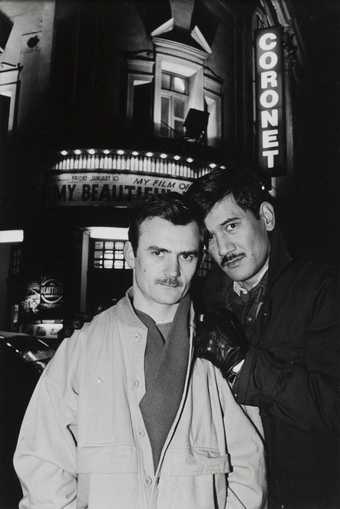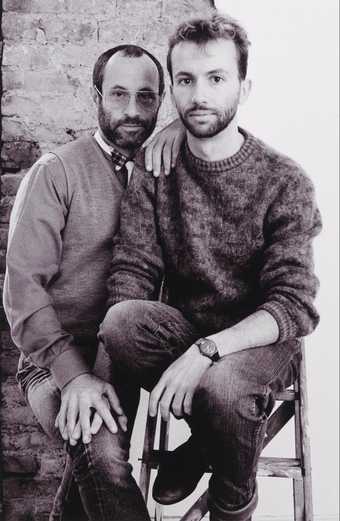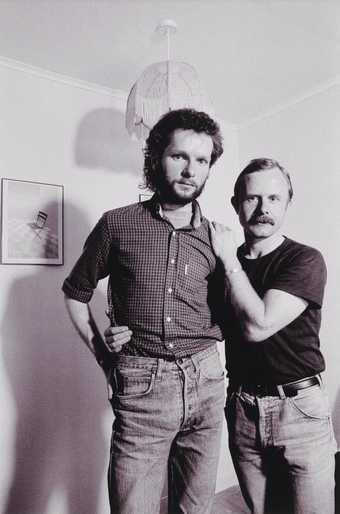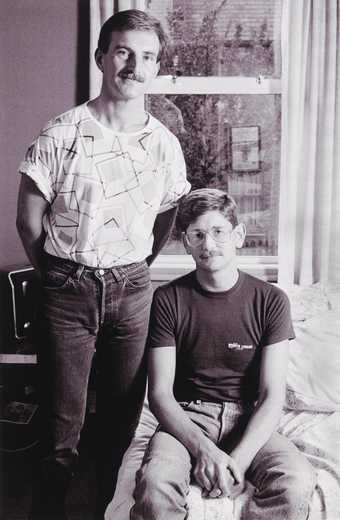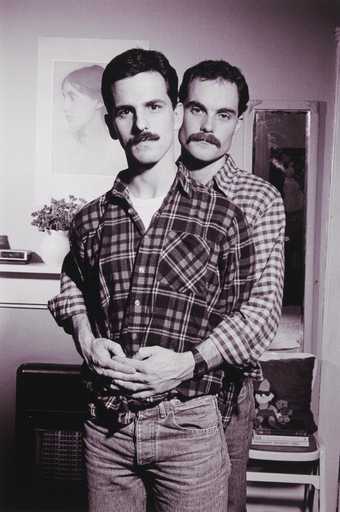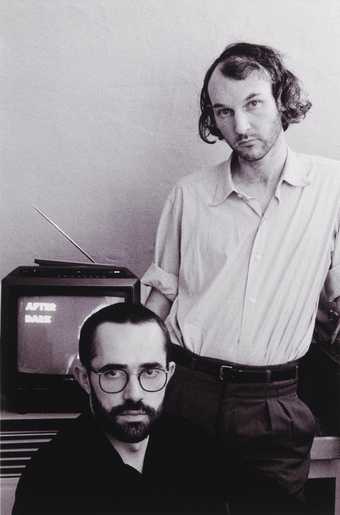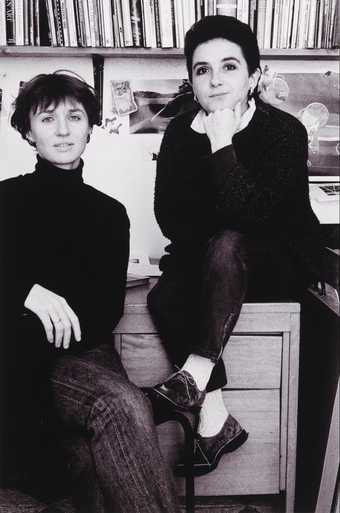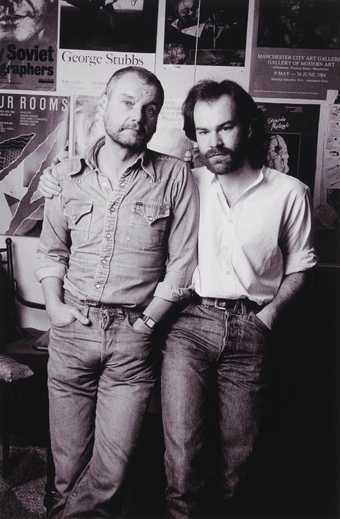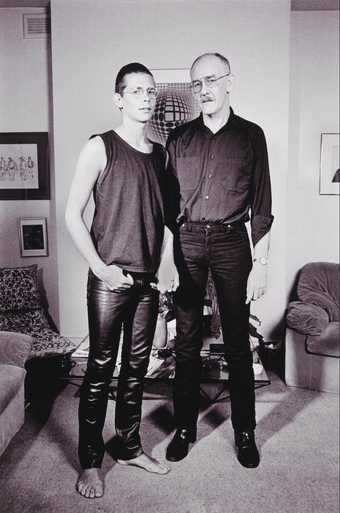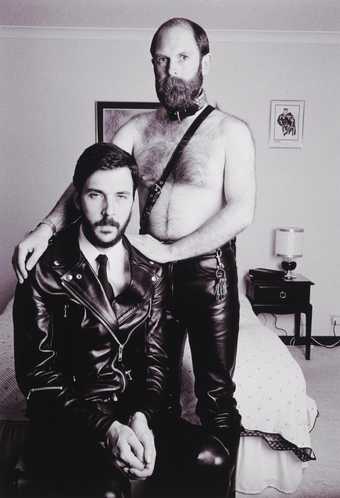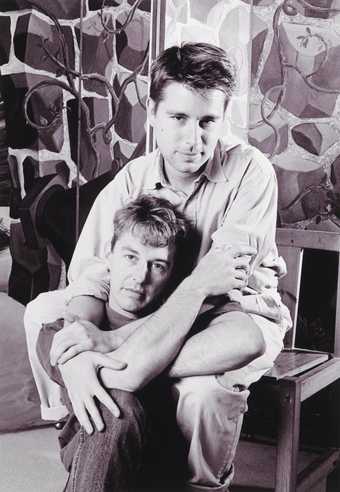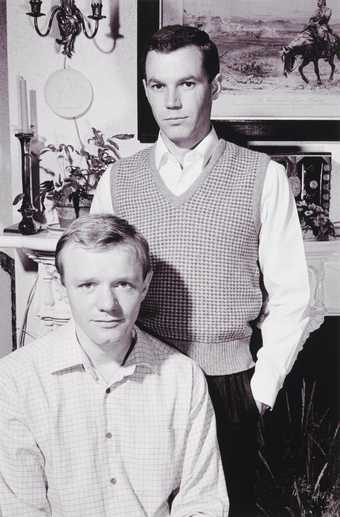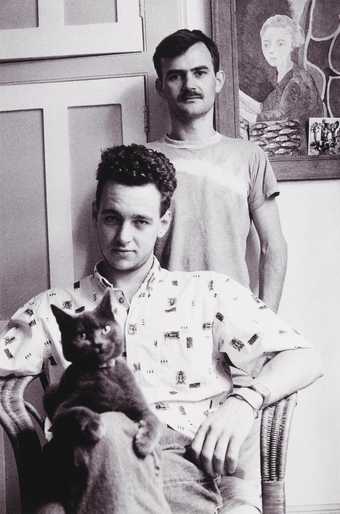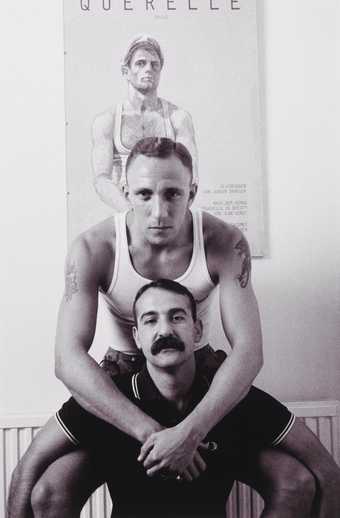
Not on display
- Artist
- Sunil Gupta born 1953
- Medium
- Photograph, inkjet print on paper
- Dimensions
- Image: 500 × 330 mm
- Collection
- Tate
- Acquisition
- Partial gift of Rudolph Leuthold and partial purchase 2018
- Reference
- P82137
Summary
This is one of a group of photographs in Tate’s collection from Sunil Gupta’s Lovers: Ten Years On, a series of over thirty black and white portraits of gay couples taken in the United Kingdom between 1984 and 1986 (Tate P82123–P82137 and Ian and Julian P13784). With the exception of Martin & Gary, Newcastle-upon-Tyne 1984 (Tate P82123), they were all taken in London. Lovers: Ten Years On was made after Gupta’s own ten-year relationship ended and, as a form of social analysis, he decided to document the long-term gay relationships he encountered and the changing sensibilities of the social environment he found himself a part of. Most of the subjects are from his own social milieu at the time, professional couples resident in the Greater London area. Taken over a period of two years, the black and white portraits all follow the same format – they are shot in domestic interiors, the poses and arrangements reminiscent of traditional family photographs. The subjects are centred in the frame and look directly into the camera. Most of the couples are shown in affectionate poses and embraces within their domestic settings; some included their pets in the picture, others chose to be depicted in front of works of art in their living rooms, surrounded by books, or in their kitchens.
The series was accompanied by an artist’s statement, in which Gupta observed that while there had been a shift in gay self-consciousness since the 1970s, the arrival of HIV and Aids had once again turned public opinion against the acceptance of homosexuality, and that its popular and commercial representations were dominated by a stereotype of deviance. In contrast, the couples in Lovers: Ten Years On are shown as often quite ordinary, white middle-class, professional people in long term monogamous relationships. Gupta wrote:
Couples seem to have come into their own. Gay self-help groups encourage a change in sexual behaviour and a reduction in the number of partners. However, still without legal recognition, with the new emphasis on monogamy, with social attitudes reverting to hostility and given the visibility of day-to-day life for gay men within relationships, being a partner now can prove to be as difficult as it was a decade ago.
With one exception, these photographs were made in London. The couples define themselves as such by various criteria; some live together, some don’t, some have been together a short time, some a very long time, and so on. I believe the relationship between gay men is an important but often neglected component of their lives.
(Gupta, Artist’s Statement for Lovers: Ten Years On, 1985.)
The historian Stuart Hall described Gupta as ‘focusing a diasporic sensibility on that most mysterious of entities – the English, “Englishness” and its vicissitudes. He explores the dissonances between South Asian culture and metropolitan modernity, and between gay sexuality and the modern world.’ (Hall 2001, p.51.) Gupta was engaged with Aids-related activism even before he was himself diagnosed as HIV positive in 1990, the year in which, together with Tessa Boffin, he curated the Arts Council touring exhibition Ecstatic Antibodies. The exhibition was accompanied by the publication Ecstatic Antibodies: Resisting the AIDS Mythology. Many of the subjects photographed in Lovers: Ten Years On lost their lives to the Aids epidemic.
Gupta took up photography while he was studying for a business degree in New York in the 1970s. After workshops with Philippe Halsman and Lisette Model (who taught Diane Arbus) at the New School for Social Research, he pursued photography full time. Interested in ‘concerned’ documentary and issue-based reportage, and influenced by American photographers such as Arbus, W. Eugene Smith and Lee Friedlander, Gupta found that London in the late 1970s lagged behind in the theoretical discourse surrounding representational images and racial sensibilities. Hall wrote about his practice: ‘Inevitably most of his work is an “issue-based” art with a deliberately polemical edge. “The making of my own cultural history” – including his own implication in sexual and racial difference – became his artistic project’s central theme.’ (Ibid., p.50.) Politically committed, Gupta was drawn towards both gay and multicultural activism in London.
Motivated by leaving a legacy, self-consciously ‘trying to make cultural history’ at a moment when ‘structuralism was in’, Gupta focused his visual practice on representation (in conversation with Tate curator Nada Raza, 27 March 2014). Lovers: Ten Years On marks a key moment in his artistic development. Despite his wide network within the Black (then a blanket term for all minorities) arts movement, Gupta found these images difficult to exhibit at the time, and the full series of almost thirty photographs has only been shown in its entirety once to date, in 1984 at Five Dials Gallery, London. Gupta has attributed this to the prevailing absence of black artistic agency as well as to the discomfort of acknowledging interracial male or homoerotic desire. Viewed from a present-day perspective, the photographs in Lovers: Ten Years On stand out for their deliberate staging and the complicit participation of Gupta’s subjects, as well as his complex relationship with them as simultaneously insider and outsider.
Further reading
Sunil Gupta, ‘Desire and Black Men’¸ in David A. Bailey and Stuart Hall (eds.), Critical Decade: Black British Photography in the 80s, in Ten 8, vol.2, no.3, 1992, pp.80–7.
Stuart Hall, Different, London 2001. p 50.
Nada Raza, Elsa Coustou, Kate Bush
March 2014, updated December 2017
Does this text contain inaccurate information or language that you feel we should improve or change? We would like to hear from you.
Explore
- emotions, concepts and ideas(16,416)
-
- formal qualities(12,454)
-
- documentary(1,026)
- photographic(4,673)
- domestic(1,795)
- individuals: female(1,698)
- UK countries and regions(24,355)
-
- England(19,202)
- London - non-specific(3,659)
- sex and relationships(833)
-
- couple(1,322)
- lesbianism(262)
You might like
-
Sunil Gupta Untitled from the series Reflections of the Black Experience
1986, printed 2010 -
Sunil Gupta Ian and Julian, from the series Ten Years On
1986, printed 2010 -
Sunil Gupta Bruno & Daniel, London
1984, printed 2018 -
Sunil Gupta David & Peter, London
1984, printed 2018 -
Sunil Gupta John & John, London
1985, printed 2018 -
Sunil Gupta Johnathan & Kim, London
1985, printed 2018 -
Sunil Gupta Guy & Brian, London
1984, printed 2018 -
Sunil Gupta Sue & Yve, London
1984, printed 2018 -
Sunil Gupta Emmanuel & David, London
1984, printed 2018 -
Sunil Gupta Andrew & John, London
1985, printed 2018 -
Sunil Gupta Dylan & Gerald, London
1985, printed 2018 -
Sunil Gupta Simon & John-Paul, London
1985, printed 2018 -
Sunil Gupta Karl & Daniel, London
1985, printed 2018 -
Sunil Gupta Roger & Steve, London
1984, printed 2018 -
Sunil Gupta Ian & Pavlik, London
1984, printed 2018

